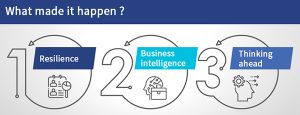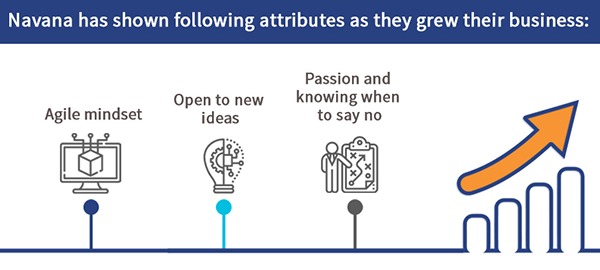Bridge2Capital and Navana: Seniors of the batch!
 by Anshul Saxena and Anil Gupta
by Anshul Saxena and Anil Gupta Jun 24, 2020
Jun 24, 2020 8 min
8 min
One of them is transforming invoice financing and the other one is transforming mobile applications to serve the underserved – here we uncover stories of two alumna start-ups who joined us from cohort 1 into cohort 2.
This blog is about a startup in the Financial Inclusion Lab accelerator program, which is supported by some of the largest philanthropic organizations across the world – Bill & Melinda Gates Foundation, J.P. Morgan, Michael & Susan Dell Foundation, MetLife Foundation and Omidyar Network.
Brothers Raoul and Jai Nanavati started Navana Tech in 2018 from their study room. At around the same time, Mohammed Riaz and Nishant Singh left their senior positions in well-established companies to pursue their entrepreneurial ambitions, which bore fruit as Bridge2Capital. Today, while Navana Tech is a part of the elite list of top 30 tech startups in India, Bridge2Capital has been shortlisted as one of the most promising fintech startups by India Fintech Awards Association.
Bridge2Capital and Navana have been with the Lab since the first cohort. In a way, the Lab and both the startups have grown together since day one.
Though they are from the same cohort, the founding teams are quite a contrast to each other. Bridge2Capital comprises veterans who have deep and vast experience in the rural distribution space in India. On the contrary, Navana Tech comprises younger blood and recent Cornell graduates who seek to build software for the low-literate and low-income groups of India. Yet their passion to serve the low- and moderate-income (LMI) segment that remains vastly underserved is a common bond that ties them and our Lab together.
Bridge2Capital’s journey so far
Bridge2Capital started with a simple idea: to support local mom-and-pop stores, or Kirana stores as they are known in India, to turn their inventory over in the most productive way. These stores usually depend on supplier credit to stock inventories and sell to customers. They do not have much in terms of credit history as they deal in cash, which does not leave a digital or a paper trail. Hence, they are mostly unable to provide sufficient proof of their business flows and get loans from formal financial institutions to expand and grow. Bridge2Capital solves this problem by financing these small shopkeepers based on GST-authenticated supplier invoices.
Though Bridge2Capital was doing quite well at the end of the first cohort, it was able to muster only around 200 odd shops from three to four tier-II and III Indian cities on its platform. You can read about Bridge2Capital and its business model in our previous series on cohort 1. Now, after the second cohort concluded, Bridge2Capital has on-boarded more than 1,000 shopkeepers across 18 tier-II and III cities of India on its platform.
What made it happen?

A few factors contributed to this:
- Resilience: The Bridge2Capital team kept on going to different kinds of shops to collect data, such as the size of the shop, history of existence, and information about the shopkeeper. The team tested each cohort of shops and shopkeepers carefully with small loan sizes. They failed many times in those pilots, but with each failure, they learned what not to do and made sure they did not repeat their mistakes.
- Business intelligence: The founding team has built a data-centric culture in the startup. The on-field teams collected data methodically and objectively and paid equal attention to organizing it. This allowed Bridge2Capital to utilize the data quickly, to run nimble experiments, and to select and persist with the right kind of shopkeepers—ones who could and would pay them at regular intervals with minimum interventions.
- Thinking ahead: Startups need to evolve continually—not only to stay ahead of the competition but also to stay motivated and dream of bigger achievements. Like many other credit-underwriting fintechs that use alternate data, Bridge2Capital had built a robust algorithm to generate a reliability score based on the payment history of each of its onboarded shopkeepers.
However, it realized that the market lacked a technique to ascertain the intent of the shopkeeper or borrower in general to pay their dues.
Therefore, Bridge2Capital started to explore other methods, such as behavioral analysis and psychometric evaluations to see how these can be combined with its existing credit underwriting algorithms, to produce even better and more reliable predictable scores for existing and new shopkeepers.
The Lab supported Bridge2Capital in becoming more efficient and productive
The Lab helped the startup team through a mix of academic and pragmatic approaches. The boot camps and classroom sessions took an academic approach to build a business, while the field surveys, market research exercises, and data analysis defined and delivered a practical approach to lending. The support allowed Bridge2Capital to:
- Lower its customer acquisition costs by identifying and overcoming inefficiencies in the customer onboarding process.
- Experiment with newer ideas to enhance business productivity and learn what it should not do.
Helping shopkeepers in the time of the COVID-19 pandemic
Empathizing with its customers, the shopkeepers, Bridge2Capital has introduced the following measures to ease the financial hardships caused by this pandemic:
- It has allowed its shopkeepers to convert their short-term loans (payable within a month or two months) into longer-term loans that span six to 12 months, by paying up a small conversion fee.
- It has allowed Reserve Bank of India’s (RBI’s) three-month moratorium on the repayments for its shopkeepers. Many shopkeepers are still willingly paying the interest part of their borrowings during this period.
- It has introduced a new product, Bridge2Pay to enable its shopkeepers to receive payments in a “presence less” mode, to maintain social distancing. The shopkeeper uses WhatsApp to forward a unique QR code generated by Bridge2Capital to its customers. This helps the customer to just scan the code through their mobile phones and pay the shopkeeper through Unified Payment Interface (UPI).
Navana Tech: Adapt-as-you-go
You already know about Navana Tech from our previous blog series, so we will talk about what the brothers, Raoul and Jai, have been up to since then. From the beginning of the first cohort until today, Navana Tech has continued to pivot its product ideas. It started from an operating system (OS) layer over Android OS and moved to a simpler, text-light, image-based phonebook app, from which it transitioned to a software development kit (SDK). The SDK allows businesses, especially banks, to build mobile applications for the illiterate and semi-literate populations of the country.
One constant for the company has been its steadfast focus on serving the community of users who form a bulk of the LMI segment of our country. It has a deep understanding of the user experience of its customer segment and has expertise in building intuitive user interfaces for them. This has earned it a place among other promising startups of not only the FI Lab but also among the Microsoft for Startups program.
Today, Navana Tech partners with prominent microfinance institutions (MFIs) and small finance banks (SFBs), such as Ujjivan and Shubh Loans. These institutions serve the LMI segment across the country by lending to them at reasonable interest rates. However, these MFIs and SFBs faced challenges in transforming their manual, paper-driven processes of a regular bank to automated, digital, and more user-friendly processes. Navana is helping them do that today.
Navana Tech has also recently gone beyond the financial services domain and started running pilots with Digital Green to help it develop hyper-local mobile applications. The applications allow small landholder farmers to become entrepreneurs, who in turn recruit other farmers and sell their collective produce to suitable marketplaces nearby.
Navana Tech created a user interface (UI) that uses voice and natural language processing (NLP) to “hear” and “understand” what a customer speaks in their local languages. By doing this, Navana Tech is breaking a pivotal barrier that can help bring the LMI segment into the fold of regular smartphone users who perform a variety of tasks, such as mobile banking from the place of their choice.
The start-up’s team continues to run pilots with these institutions and enrich its database to build robust solutions that can serve a range of people who speak different dialects.
The team started with barely a minimum viable product (MVP) with no clients at the beginning of the first cohort, with both the founders working from their homes in Mumbai. Today, Navana Tech has moved to a formal office space in Whitefield, Bengaluru. It employs a team of nine, with three clients: Ujjivan, Shubh Loans, and Digital Green in its kitty.
Navana has shown the following attributes as it grew its business:

- Agile mindset: The team led by the brothers, developed its software in multiple, short iterations by continually testing it with their pilot customers and feeding their concerns into making better designs.
- Open to new ideas: The Navana team has not confined itself solely to the domain of financial services. Today, it works with Digital Green, an agri-services provider, and intends to work with a few healthcare companies that cater to the LMI segment.
- Passion and knowing when to say no: Despite having some lucrative opportunities after graduate school, the brothers stuck to their plan and refused to take up opportunities that could have diverted them from their vision of serving semi-literate and illiterate people.
Surviving the pandemic
The COVID-19 situation has been particularly harsh for Indian startups. The payments that existing clients owe them are delayed, and no new clients are willing to give business. Given this, the Navana Tech team has been taking the following measures to survive:
- The startup has reduced its variable costs by switching to cheaper tools for software product development.
- It has initiated conversations with prospective clients, including non-financial service providers, and offered them freemium versions. The terms of payment for these versions are flexible and the clients can opt-out at any time. This strategy has strengthened its sales pipeline.
Way forward
The COVID-19 pandemic has had an impact on startups like Bridge2Capital and Navana Tech. Their short-term goals for growth have been deferred. However, both teams have been quick to adapt to the situation. Their immediate plans are to survive through the next 3-6 months by staying lean in terms of staff-strength and nimble in terms of strategy and implementation to adapt to the rapidly changing business environment. They have plans to consolidate their businesses with their existing clients or customers, build more digital features in their products, and keep their team’s morale high.
This blog post is part of a series that covers promising FinTechs that are making a difference to underserved communities. These start-ups receive support from the Financial Inclusion Lab accelerator program. The Lab is a part of CIIE.CO’s Bharat Inclusion Initiative and is co-powered by MSC. #TechForAll, #BuildingForBharat
Written by


Leave comments